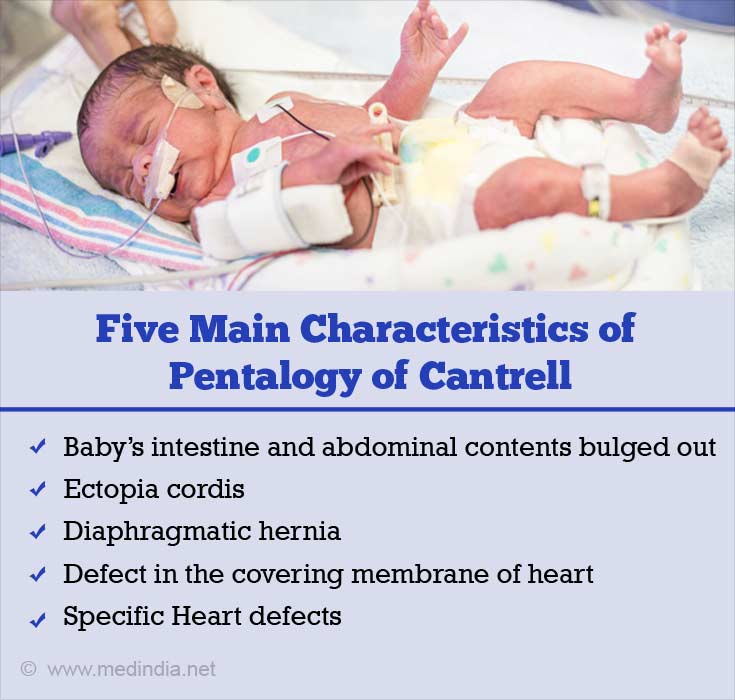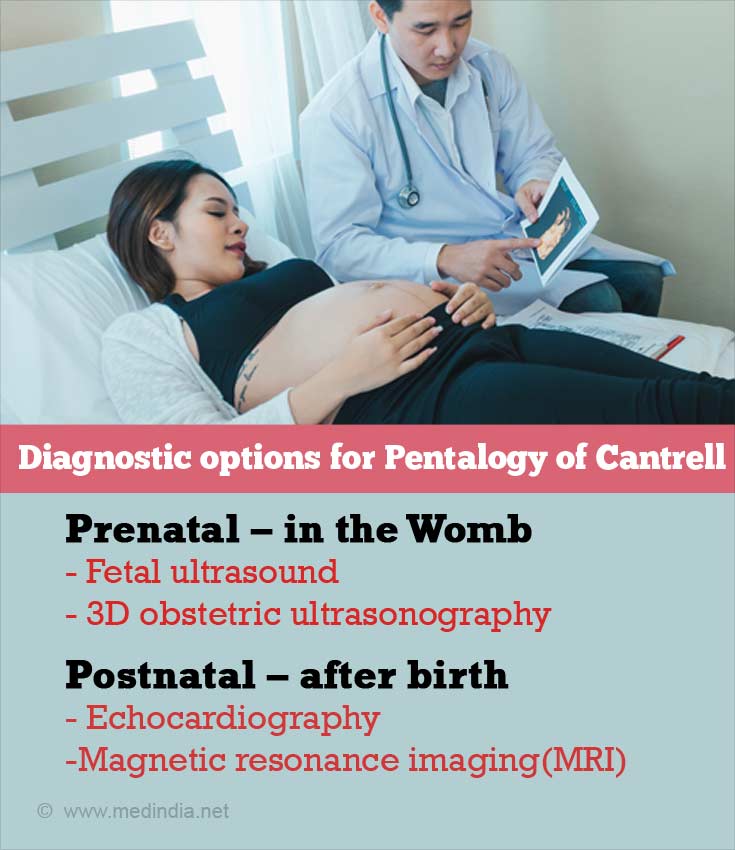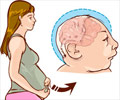- Information About Pentalogy of Cantrell - (https://rarediseases.org/rare-diseases/pentalogy-of-cantrell/)
- What is Pentalogy of Cantrell? - (https://en.wikipedia.org/wiki/pentalogy_of_cantrell)
- Pentalogy of Cantrell - (https://www.childrenscolorado.org/conditions-and-advice/conditions-and-symptoms/conditions/pentalogy-of-cantrell/)
- Know About Pentalogy of Cantrell - (https://radiopaedia.org/articles/pentalogy-of-cantrell-3)
What is Pentalogy of Cantrell?
Pentalogy of Cantrell or thoracoabdominal syndrome is an extremely rare birth disorder with an incidence of 6 per million births. As the name indicates, Pentalogy of Cantrell involves a combination of five birth defects affecting the breastbone (sternum), the diaphragm (muscle that separates the chest and abdominal cavities and helps in breathing), the covering of the heart (pericardium), the heart and abdominal wall.
The condition shows varying degrees of severity, and may result in severe, life-threatening complications. Most babies do not have all of the five potential defects, when it is termed incomplete pentalogy of Cantrell. If all five defects occur, this is termed complete pentalogy of Cantrell. The exact etiology (cause) of pentalogy of Cantrell is unknown. The condition mostly occurs in a scattered manner and in a random fashion without any definite pattern.
The condition was first described in 1958 by James Cantrell.
What are the Five Characteristics of Pentalogy of Cantrell?
Pentalogy of Cantrell comprises the following 5 main features
1. Defective formation of the central portion of the coverings of the abdominal organs which form the protective abdominal wall. This gap is found mostly in the upper portion of the abdomen above the navel. Through this gap, the baby’s intestine and abdominal contents bulged out enclosed within a covering sac (omphalocele)
2. Improper formation of the lower part of the chest (breast) bone or sternum plus/minus abnormal location of heart outside its normal position referred to as ectopia cordis
3. Defect in diaphragmatic muscle with diaphragmatic hernia
4. Defect in the covering membrane of heart
5. Heart defects
- Defect in wall or septum separating the two upper chambers (ventricular septal defect VSD)
- Defect in wall or septum separating the two lower chambers (atrial septal defect ASD)
- Tetralogy of Fallot (a complex birth defect having 4 distinctive components)
- Left ventricular diverticulum (localized outpouching of the left ventricular wall)

How is Pentalogy of Cantrell Classified?
A diagnostic classification system suggested by Toyama is as follows:
- Class 1 - Definitive diagnosis, with presence of all five characteristic defects
- Class 2 – Probable diagnosis – four out of five characteristic defects present, including abdominal wall defects and heart abnormalities
- Class 3 - incomplete expression, with occurrence of defects in varying combinations, including an abnormality of the breast bone
What is the Cause of Pentalogy of Cantrell?
The exact cause of pentalogy of Cantrell is not clear. Most cases occur in a random and scattered manner without any reason even in families where no one has been affected before.
- Abnormal formation of midline tissue in the developing embryo between 14 to 18 days following conception is one of the suggested hypotheses
- Familial cases have been reported affecting members of the same family suggesting a possible role of genetic factors
However more studies are needed to identify the possible reasons that may be causing the disease.
What are the Symptoms and Signs of Pentalogy of Cantrell?
- Varying combinations and severity of the five main defects mentioned above
- The most severe form of the condition is when the baby is born with abdominal organs bulging outside through their defective covering (omphalocele) and when the heart is located outside its normal position in the chest cavity (ectopia cordis)
- Severe respiratory distress and bluish discoloration of skin and lips at birth
- Diastasis (defect) of abdominal muscles
- Complete or partial absence of breast bone (or sternum), abnormally short sternum or cleft in the sternum
- Other associated anomalies
- Cleft lip and palate
- Defective development of kidneys
- Abnormalities of skull and face
- Fluid-filled mass or sac in the head and neck region (cystic hygroma)
- Limb defects (Absent bones in the arms or legs, club foot) and
- Birth defects of the brain and spinal cord (neural tube defects).
- Associated chromosomal defects such as trisomy 13, 18, Down syndrome or Turner syndrome
What are the Complications of Pentalogy of Cantrell?
- Respiratory difficulties due to defective lung development and diaphragmatic defects
- Impaired heart function and heart failure
- Abnormal electrical activity of heart and arrhythmias
- The bulging portion of the ventricular wall may sometimes give way resulting in death
- Increased risk of developing widespread infection (peritonitis) of the abdominal cavity
- Thickening of blood and clot formation within the blood vessels which will affect blood flow and oxygen supply to various parts of the body
How do you Diagnose Pentalogy of Cantrell?
Prenatal – in the womb
A diagnosis of pentalogy of Cantrell can often be made before birth (prenatally) by a fetal ultrasound. When heart defects and defects in the coverings of the abdominal organs are found, (such as ectopia cordis with omphalocele) ) a diagnosis of pentalogy of Cantrell should be suspected and other components of the syndrome should be specifically looked for
Early diagnosis offers parents the option of early termination of the pregnancy. Small defects located in the sternum, pericardium or diaphragm, and in the absence of obvious herniation of the heart are difficult to diagnose. 3D obstetric ultrasonography can be used to confirm the diagnosis during the second and third trimesters of pregnancy
Post natal – after birth
An echocardiography (ultrasound of heart) will help to assess the extent of the involvement of the heart and the associated defects
Magnetic resonance imaging (MRI) may also be performed which gives detailed pictures of chest and abdominal organs to assess the severity of abdominal wall and pericardial defects.

How is Pentalogy of Cantrell Treated?
Termination of pregnancy should be considered when imaging tests such as ultrasound done during pregnancy indicate complex and severe abnormalities in the heart that suggest the chances of survival of the baby are low
In parents who opt to continue with pregnancy, treatment depends on the severity of defects and which organs and tissues have been affected. Treatment plan will vary from one case to another depending on several factors, such as the size and type and severity of abdominal wall defect, nature and severity of heart defects, and the specific type of ectopia cordis
Affected babies need complex medical care and surgery to correct these defects and the survival of the baby often depends on surgery to correct the abnormalities. Unfortunately even with treatment, many of these babies die and treatment is often largely supportive or palliative
Mild or isolated defects
Correction of an omphalocele necessitates surgery soon after birth. Concurrently, surgeons may also try to repair other defects including defects in the diaphragm, pericardium and breast bone
Multiple defects
In certain severe cases, doctors recommend staged repair of the various defects present in pentalogy of Cantrell. The first stage of surgery immediately after birth addresses separation of the abdominal and heart cavities, omphalocele repair and closure of the midline defect. Following appropriate growth of the thoracic cavity and lungs, the second stage involves repair of the heart defects and placing the heart back in its position.
By two or three years of age, reconstruction of the lower breast bone and abdominal wall may be necessary.









